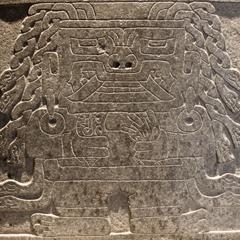By Natalie Villacorta
A lot of hand-waving goes on in the emerging field of archaeoacoustics. The pioneers of this field—which made its debut for the general science community Feb. 17 at the American Association for the Advancement of Science meeting in Vancouver—are perhaps summoning the spirits who occupied the ritual spaces they study.
These researchers draw on archaeology, acoustics, and music to assess whether the architects of notable ancient sites designed their structures with more than one sense in mind.
Wearing a “Stonehenge rocks!” t-shirt over his button-down shirt, independent scholar Steven J. Waller from La Mesa, Calif., said the pattern of that renowned English structure reminded him of a wave interference pattern. When two sounds are played simultaneously, he explained, they cancel each other out at repeated spots within Stonehenge—in much the same way as noise-canceling headphones work.
Carvings and structural patterns in the 3,000-year-old Chavín de Huántar ceremonial center in Peru suggest that its builders kept acoustics in mind. Credit: Miriam Kolar/Stanford UniversityWaller tested the hypothesis that ancient peoples experienced this phenomenon and created Stonehenge in response. He had two bagpipers match their tones in the center of a field as he walked in a perimeter around them. “Intuitively, you would expect that two pipers would sound louder than one piper,” Waller said at the meeting.
But that’s not what he heard. In some places, the sound was actually muted. His perception was that “something was blocking the sound.”
Six blindfolded subjects all reported similar experiences, Waller said. “They could not believe there was nothing there,” he said.
This wave-interference pattern served as the spacing design for the vertical rocks of Stonehenge, Waller believes. During the AAAS session, he described legends that support this theory. He is now advocating to preserve the soundscapes of these archaeological sites, along with their physical structures.
Miriam A. Kolar, a Ph.D. candidate at Stanford University's Center for Computer Research in Music and Acoustics, also finds evidence of intentionality in the design of Chavín de Huántar, a 3,000 year-old temple in the Andes Mountains of Peru. She studied the temple’s labyrinthine spaces to determine how they filter and transmit sound.
Inside of Chavín is the Lanzon monolith—a statue carved with a human face that Kolar believes was purposefully designed to propagate sound. The oracle’s mouth is aligned with a duct that goes out to the temple’s plaza. “The oracle can be made to speak,” she said.
Kolar found that the physical shape of the duct selectively filters for sound of a pututu, a conch-shell trumpet that ancient peoples may have used in ritual performances. Kolar’s team played the pututu to determine the many kinds of noises it can produce, including emulating the roars of felines.
“What does it all mean? We’re trying to put it together,” Kolar said in the session.
Kolar has concluded that the acoustics of these ancient stone galleries can influence human perception in predictable ways.
Waller’s findings on paintings within Utah canyons also suggest that ancients were aware of the ways that architecture can disorient perception of sound. Echoes within some caves are most intense at the locations of rock art, Waller reported. For instance, a depiction of a stampede marks the spot of a thunderous reverberation produced by hand clapping, he said. There's less than one chance in 10,000 for that alignment to happen randomly, he claimed.
“If you stand back, these paintings will actually speak to you,” he said. “It’s greater than any cathedral you’ve ever been in.”
However, David Lubman of the Acoustical Society of America found an alternative explanation. The sites with the most sonic resonance are also sites of nonporous rock, Lubman reported. Painters would have chosen these places because they do not absorb paint, he said, not necessarily because of their relationship to sound.
Natalie Villacorta is a junior at Brown University studying biology and English. She is a senior editor at the Brown Daily Herald and previously interned at Science magazine. Reach her at natalie_villacorta@brown.edu or follow her on Twitter: @nvillaco.




